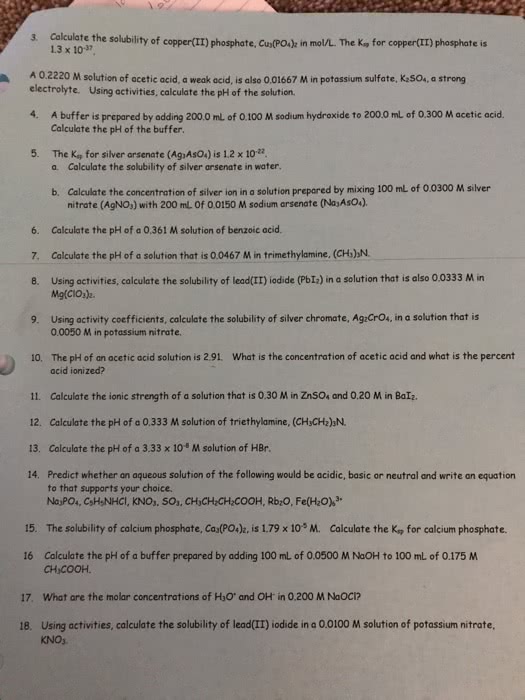1-A 3.744 g sample of copper(II) nitrate is dissolved in water and 2.000 g of copper(II) arsenate (Ksp = 7.6 x 10-36) is added so that the total solution volume is exactly 1 L. What is the concentration of the arsenate ion in the solution (assuming the arsenate ion does not react with water)? (b) If the arsenate ion does react with water, write the principal chemical equation and determine K.
2- Argentous iodide (Ksp = 8.32 x 10-17) is considerably less soluble than argentous chloride (Ksp = 1.82 x 10-10). Determine the stoichiometric concentration of (a) ammonia and (b) sodium thiosulfate that is required to dissolve argentous iodide, such that the total dissolved silver concentration is 0.100 M. (The equilibrium constants (K1, K2) for the stepwise formation of the argentous-ammine and argentous-thiosulfate complexes are 2.1 x 103 , 8.2 x 103 and 7.4 x 108 , 3.9 x 104 , respectively.)
1-A 3.744 g sample of copper(II) nitrate is dissolved in water and 2.000 g of copper(II) arsenate (Ksp = 7.6 x 10-36) is added so that the total solution volume is exactly 1 L. What is the concentration of the arsenate ion in the solution (assuming the arsenate ion does not react with water)? (b) If the arsenate ion does react with water, write the principal chemical equation and determine K.
2- Argentous iodide (Ksp = 8.32 x 10-17) is considerably less soluble than argentous chloride (Ksp = 1.82 x 10-10). Determine the stoichiometric concentration of (a) ammonia and (b) sodium thiosulfate that is required to dissolve argentous iodide, such that the total dissolved silver concentration is 0.100 M. (The equilibrium constants (K1, K2) for the stepwise formation of the argentous-ammine and argentous-thiosulfate complexes are 2.1 x 103 , 8.2 x 103 and 7.4 x 108 , 3.9 x 104 , respectively.)


